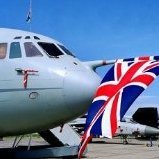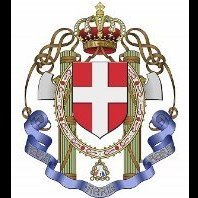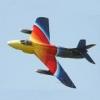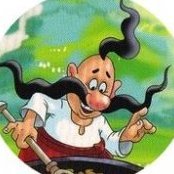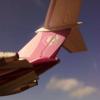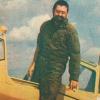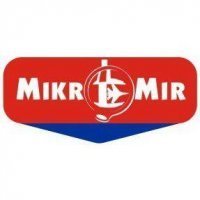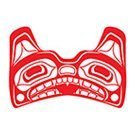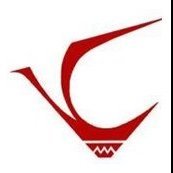Search the Community
Showing results for tags 'Amodel'.
-

1/144 - Grumman UF-1/HU-16B Albatros by Amodel - released
Homebee posted a topic in The Rumourmonger
Amodel is to release a 1/144th Grumman UF-1 Albatros kit - ref. 1424 Source: https://www.aviationmegastore.com/grumman-uf1-albatros-amdl14424-a-model-amdl1424-aircraft-scale-modelling/product/?action=prodinfo&art=79900 Box art V.P. -
D.H. 60T Moth 1:72 Amodel First flown nearly 90 years ago, the DH-60 Moth series of 2 seat biplanes were a great success and were widely used by civil clubs in the inter war period. By the late 1920's almost 85% of aircraft used by UK flying clubs were DH-60's of one type or another. It was developed though several versions, the most notable being the DH-60G Gypsy Moth, and the DH-60M 'Metal Moth' where the wooden 'skeleton' of the fuselage structure was replaced by a metal one. Various engines were used such as the Genet, Cirrus, and Gypsy, and this would often prefix the name of the version, and total production ran to about 1,640 examples. The final version had swept back wings, a strengthened structure, and a Gypsy III engine. It had so many changes that it became a distinctly different machine and was renamed the DH-82 Tiger Moth. The kit. Amodel of Poland have released a range of DH-60 Moth variants in 1:72 scale, covering the DH-60 Genet Moth, DH-60 Cirrus Moth, DH-60G Gypsy Moth, and DH-60X moth. Received from T7 Models for review is the DH-60T Moth trainer, which in real life was based on the DH-60M Metal Moth. The small end opening box contains 4 sprues of parts, a celluloid sheet with windscreens, a set of decals for 2 options, and the instructions. First impressions are favourable, with neatly moulded parts spread logically amongst the sprues. Moulding is with minimal flash, and no sink marks on any of the parts. The struts and other fine parts are commendably thin and delicately moulded, and the fabric effect is quite nicely done. Given that there are several versions of this kit, it is not surprising that many parts will not be required. There are optional props, rudders, wheels, exhausts, struts, headrests etc. As none of these are numbered on the sprues, reference to the parts map in the instructions will be required throughout the build. Construction is entirely conventional, starting with the cockpit. A slight oddity is that the front cockpit gets the rudder pedals, and the rear gets the joystick, as only 1 of each is provided. It will be a simple matter to scratch up a full set for both cockpits though, and you may want to source some decals for the instrument panels, as none are on the sheet. Once the fuselage is together, the lower wings and tail group are attached. Depending upon your chosen colour scheme you may wish to start the main paint job at this point, or proceed with the struts and top wing. The final stage is the fitting of the undercarriage with the smaller, fatter wheels. Rigging will be a matter of choice, stretched sprue or invisible mending thread both work well in this scale. Decals. A small decal sheet is provided for 2 options. Option 1 is a Swedish Air Force machine in a very bright red and yellow scheme. Option 2 is for PP-TZE from the Aeroclub De Santos in Brazil, wearing an overall red scheme. Conclusion. This is a neatly produced little kit that means we no longer need to rely on the ancient Frog offering for a DH-60. Amodel have got the most out of their tooling to produce a number of versions, which is a sensible and very welcome approach (The Cirrus Moth is one of my favourites). The odd lack of cockpit items is a minor detail that is quickly and easily solved, and overall this is well produced new kit that will satisfy the majority of modellers. It will go very nicely with the recent Airfix release of the DH-82 Tiger Moth, and I hope that Amodel consider kitting a few more classic aircraft from this era, a DH-80 Puss Moth would be lovely! Recommended. Review sample courtesy of
-
Recent completion for a GB elsewhere. The F-4F was the mainstay fighter for the US Navy (and Marines) in the early phase of the war in the Pacific. When faced with the lack of suitable airfields in places like the Solomons, the approach the Japanese used by employing floatplanes was investigated and one single F-4F-3 was converted to a floatplane for testing. The floats and reinforcement knocked a fair bit of performance off of what the F-4F had. If it wasn't for the effective Seabees (CB - construction batallions) managing to rapidly roll out airstrips, this might have been a more common sight. Amodel's Wildcatfish is a bit of a rough kit - think short-run. Soft, soapy plastic that deforms somewhat easily. My example had some warpage in the fuselage and floats, but judicious employment of clamps, tape, brute force and filler meant I at least could deliver some semblance of an aircraft on floats Some light rescribing and riveting on the otherwise lacking details, Vallejo Model Air 71.298 M.485 NS Light grey, Mr.Hobby H51 Light Gull Grey on the undersides and topside: VMA 71.109 PRU Blue & AK Realcolour RC256 M485 NS blue grey
-
Hello all, Just finished this one after leaving it alone for a month because of a catastrophic liquid glue spill! In truth it nearly went in the bin, but then I decided to use it as a weathering practise piece. The kit is short run injection but has quite a lot of detail which is typical of Amodel, its even got the fuel tanks. It took quite a bit of filler around the bomb bay area to bung up the cracks, but otherwise it wasn’t too stressful a build. (until I flung the glue pot at it anyway) The aircraft depicted is from the 328 AR of the VVS circa 1945. Around 390 of this later version with diesel engines were built from 1944 onwards and became a major part of the bomber wing of the VVS. I thought I’d do this colour option as it had splinter camo which I thought was a bit unusual for a WW2 Russian aircraft. It’s finished with Xtra colours and many different weathering attempts! Incidentally if you have one of these in your stash use decal restorer or replacement stars as the supplied ones won’t come off the backing without disintegrating. So, here it is. Thanks for looking Pete
- 28 replies
-
- 65
-

-
Welcome! I'm starting my workshop with another model KSR-5 "Raduga" (AS-6 "Kingfish") in 1:72 scale from AMODEL, it won't be crazy. Model started years ago, a little kicked, but it happens when you learn. But that was only thanks to my wife, who told me to get my models in order and tidy up the studio. Without any disguise I took the first model whose box was already a little bit shabby. After opening the box I found such a state.
-
Hi All. Here is my latest completed model the AModel Caravelle 10R in Transeuropa livery. Cheers Ray
-
With the Supermarine 224 finished and the Dewotine D510 at the painting stage, I think I might have time for least another entry. So I have started an Amodel Hawker Fury that I have in the stash. This is a 'short run' kit that offers the wheel spats for the Mk II and nice surface detail, but is probably a harder build than the Matchbox kit I first built in the summer of 1973 after my First Year Uni exams. The Mark II Fury was an upgrade to the original Fury bought by the RAF. It had a more powerful Kestrel engine, wheel spats and increased fuel tankage which gave it a top speed of 223 mph compared to 205 mph of the original Fury. 100 were built and production started in late 1936 and the type entered service in early 1937. It was only ever seen as a stopgap and remained with a handful of squadrons for a short period until replaced something a bit more potent. Front line units equipped with the Fury II were 25, 41, 73 and 87 Squadrons, some as interim equipment for a few months with 41 having them longest from between October 1937 and January1939 when they were replaced by Spitfires. The Amodel kit is moulded in fairly hard pale grey plastic. Most parts display noticeable mould lines but no flash and some parts like the struts are quite delicate and will require care to remove them. Surface detail is restrained with the fabric areas being muted with none of the sagging associated with some kits of fabric covered aircraft, One small clear part is provided for the windscreen and the decal sheet provides markings for two Mk I's and a Mk II. The decals are matt and some colours look a bit dubious. The only areas of shrinkage on my sample was on the spatted wheels that I wanted to use and the prop, so out has come some filler. As always seems to be the case work started on the fuselage and cockpit. Some wall detail is provided on the fuselage halves and this was added to with a few scratch-built bits like a trim wheel and map case. There is a seat, rudder pedals and a control column that is added to a floor that never existed on real thing, but some effort has been made add details of the fuselage structure on it. The instrument panel is the correct shape and the bodies of the two Vickers machine guns are there as separate parts, but the location pins for them would leave them much too far forward. Paintwork was taken from the Mushroom Model Publication on the Fury and Nimrod and is largely aluminium with the tubular fuselage frames in black. The floor was finished to march doped fabric of the bottom of the fuselage. The lower wings area butt fit and so to make the join stronger and before too much work was done on the fuselage, I drilled a couple of holes and inserted some plastic rod that fit into holes drilled in the wings. Mrs T is out at the surgery until 8.00pm giving coronavirus jabs and so the fuselage will go together. No location pins, but everything lines up nicely by the look of it
-
Soviet long range interceptor, from the mid-50's. Not really a well known type I suppose - but a cool looking plane nevertheless. There were also reconnaissance variants derived from this type. The kit is A Model Yak-25K/S: The box is quite full and doesn't look to be original. Plenty of stuff to work with. The plastic is soft, almost rubbery. Very dirty and has lot's of cleaning to do... Details are soft at best. Panel lines look like they have been rescribed by... me, really. And that's not a compliment The scheme I will be doing, same as in the box art. So this is not going to be easy kit, I can see that already. Kinda dreaded how this will work out but we will see Wish me luck!
- 17 replies
-
- 11
-

-
Here is my recently completed Shavrov SH-2 Amphibian in 1/72 by Amodel. A limited run kit with the usual problems that had to be tamed. The subject was enhanced with the use of the PE set from NH Detail and a replacement engine from Pavla. The are of concern in this case was the central struts that had to be corrected and the manufacture of a small wind pump. Painted using Colourcoats enamel paints and a mixture of kit & DIY decals. Uschi line used for the control lines. As a new thing for me, I thought I'd make a small dio for the subject; a slipway with a bit of 'water', some scenic stuff and a figure/ fuel drum from Zvezda. WiP: Thanks for looking. Stuart
- 15 replies
-
- 34
-

-

-
Amodel is to release a 1/72nd Eclipse 400 kit - ref 72369 Source: https://www.aviationmegastore.com/eclipse-400-72369-a-model-amdl72369-aircraft-scale-modelling/product/?action=prodinfo&art=173528 Box art V.P.
-
Yak-52 as used by ETPS built from the Amodel kit and home made decals. Steve
-
The K-5 aircraft were the basis of the USSR's civilian passenger fleet in the 1930s. Sometimes they were used as agitation, sanitary, transport or even military transport. This USSR L-607 was mobilized in 1939. This machine was used during the Soviet-Finnish conflict to transport ammunition and evacuate the wounded. During the service in the VVS RKKA over the civilian registration numbers were painted red stars.
- 21 replies
-
- 41
-

-
Hi all Here's my rendition of this charming aircraft using the A model kit. The plastic is quite hard and broke about six of my. 35 mm drills drilling the rigging holes. Goes together quite well and turned out an enjoyable build. I have added lap belts to the seats along with Milliput cushions. The front control stick has been placed in the Stowed position on the stb side of the forward cockpit. Fuel line from lead wire and photo Etch aileron, elevator and Rudder actuator points added. Also added exhaust straps from photo Etch fret. Rigged with invisible thread and brush painted with Humbrol enamels. Decals are from the kit and went on very well. Love the little AA badge on the Stb engine cowling panel I started this a few years ago and it stalled so wanted to build a few stalled builds like my last ones the Tiggie and Seahawk, the Sptfire Vb and Stearman I am currently doing, oh and a Camel is now involved. I have to say picking them up again work seems to progress quite quickly anyway, enough chatting some pics below. I am very pleased with this and may consider a Gypsy Moth in the future Thanks for looking Chris
- 21 replies
-
- 40
-

-
This was my long awaited Christmas present to myself, and I intended to start it straight away (as you do!), but circumstances meant it had to wait. However, the large awkward shaped box didn't fit into the stash very well, so the time has come to finally start. What's in the box then? A one piece main section of fuselage and two wings that are of a plastic coated fibreglass construction, 13 plastic sprues, a small set of photo etched parts and a decal sheet for an Orel Avia plane. Going by my normal build speed, this could be a long haul.... Dave
-
Amodel is to release limited editions of 1/72nd Taylor JT-1 & JT-2 - ref. 72358 - Taylor JT-1 Monoplane & Taylor JT-2 Source: https://hobbyterra.com/product/plastic-model-1-72-taylor-jt-1-monoplane-taylor-jt-2-amodel-72358.html box art - ref. 72359 - Taylor JT-1 Monoplane & Taylor JT-2 Titch Source: https://hobbyterra.com/product/plastic-model-1-72-taylor-jt-1-monoplane-taylor-jt-2-titch-amodel-72359.html V.P.
-
The de Havilland Vampire has always been my favourite early jet. First flown in September 1943 (5 months before the Soviet La-7, half a year before the Japanese Ki-102 and 15 months before the He 162) she should be called a wartime design. And if she wasn’t British she would be a true WW2 fighter – unfortunately the RAF had huge numbers of already proven „430+ mph” fighters to list just the Mustang, Tempest and Griffon-Spitfires, while development of another British jet – the Meteor – was six months ahead of the „crab”. Thus the plywood-clad twin-boom marvel became the Cold War era fighter. For many years the only 72nd scale kit of this most successful British - and West European - jet (some 4.500 built, or nearly 6.000 including the Venom, whose prototype was called Vampire FB.8) was the FROG F217F, that appeared in 1971 and since 1978 (after the FROG sad demise) was available under the Soviet NOVO label. Although in my youth I have built dozens of FROG/NOVO kits their F217F (later F431) is still unknown for my eyes and hands, so I can only believe it at least looked like the Vampire. Several pictures available do prove it does. Next Vampire kit in the gentleman’s scale was Heller 80283 that appeared in 1979. Although still featuring raised (and few engraved) panel lines it had ribbed undercarriage bays. The box contained 41 parts (FROG had 36) and for next 30 years this was „the kit” used by the modellers all over the world to represent the Vampire. In this period it has been also reboxed by several other manufacturers, including Revell (since 1991) and Airfix (since 1998) as the most important ones. In 2006 there appeared super-detailed resin-cast Vampires from Czech Master Resin. IIRC more than a dozen of boxes are available, including the Mk I, the Sea Vampire, the NF, the Trainer and the Venoms. Every one contains some 50-60 resin parts, a vac-formed canopy, a coloured PE fret of 30+ details and an Eduard pre-cut mask. Unfortunately their prices (some £ 27 in my country) make such high-tech kits unavailable for my wallet. And perhaps for most of us… And then the horn of plenty gave us three brand new Vampire kits in just five years. They were the Ukrainian Amodel (in 2010), the Chinese (Dragon) Cyber Hobby in 2013 and – finally – the Czech CMK (labelled as Azur, Xtrakit and Special Hobby) in 2014. All of them feature engraved detailing, plenty of parts (almost 50 in Dragon, 60 in Amodel and 70 in CMK box) and various inbox reviews call each of them beautiful (if not splendid). Really each of them look like a Vampire… until you place two of them side by side. So the problem appears: which Vampire kit in 72nd scale is the best dimensionally- and shape-wise, as the details of all “new tool” trio are at least acceptable and their prices (£9 for CMK and £10 for Amodel) are not very high when compared to £6 for the Airfix (£8 for Revell) boxing of the ancient Heller kit. At some £19 the Cyber Hobby kit is far more expensive, while not far better. Fortunately I have the opportunity to measure the real bird (a Swiss-built FB.6) at the Polish Aviation Museum where I’ve been working between 1987 and 2014. So I took 21 various dimensions of the original, scaled them down and then measured the kits. The results are very interesting, although one can even call them horrible. It’s incomprehensible – for me at least – why can’t the 21st century kit manufacturer replicate faithfully the real plane, using instead various drawings that are far from reality. Measuring the real craft and making new drawings is far cheaper than NCM-cutting the moulds. And then we – thousands of modellers worldwide – have to use our skills to make a Vampire look like the Vampire… Full size dimensions are given in centimeters, the rest - in milimeters. Abbreviations stand for: R - real FB.5, S - scaled to 1:72, A - Amodel, C - CMK, D - Dragon Cyber Hobby, H - Heller/Revell/Airfix (FB.5) Fuselage length overall (FB.5) R610 S84.7 A81.8 C83.8 D80.8 H81.4 Sliding canopy length R122 S16.9 A18.3 C18.5 D17.8 H17.0 End of canopy to the top of nose bulkhead R192 S26.7 A26.9 C27.6 D26.3 H25.2 End of canopy to the bottom of nose bulkhead R203 S28.2 A28.5 C29.0 D28.1 H27.0 End of canopy to the tip of nose R278 S38.6 A37.2 C38.5 D37.2 H35.0 End of canopy to fuselage joint frame R105 S14.6 A13.4 C12.3 D12.4 H14.1 End of canopy to tailpipe R332 S46.1 A44.6 C45.3 D43.6 H46.4 Half of wing span R579 S80.4 A79.0 C79.9 D77.8 H79.5 Fuselage centreline to aileron inner edge R324 S45.0 A42.8 C43.4 D41.9 H43.8 Fuselage centreline to main u/c bay outer edge R262 S36.4 A34.5 C35.6 D34.7 H36.7 Fuselage centreline to flap outer edge R250 S34.7 A33.0 C33.7 D32.9 H33.0 Fuselage centreline to tailboom centreline R149 S20.7 A20.0 C20.2 D19.6 H19.3 Wing chord at aileron outer edge R99 S13.7 A13.9 C14.0 D13.0 H13.5 Wing chord at aileron inner edge R194 S26.9 A29.0 C29.1 D26.8 H25.9 Wing chord at main u/c bay outer edge R231 S32.1 A33.0 C32.3 D30.6 H30.4 Wing chord at tailboom centreline R265 S36.8 A40.5 C39.6 D38.2 H37.0 Tailboom insert into wing R190 S26.4 A26.0 C26.8 D24.4 H24.8 Tailboom length aft of joint R412 S57.2 A55.0 C56.0 D54.5 H57.4 Tailplane span (between fairings) R282 S39.1 A38.6 C38.8 D37.8 H36.8 Horizontal stabilizer chord R77 S10.7 A10.5 C12.0 D10.0 H10.6 Elevator chord R41 S5.7 A5.5 C5.8 D5.4 H5.8 So the results are: every fuselage is too short (I know that Swiss FB.6 pointed nose is longer) with CMK being the only close. Every canopy is too long with Heller being the only close – but this is easy to correct. Fuselage panel lines are wrong in each case with differences reaching 3.5 mm in scale (10” on real bird). All the wings are too short with CMK being AGAIN the only close. Same applies to the gap between the tailbooms. Chordwise Heller and Dragon wings are too narrow, while Amodel and CMK are too wide (which is easier to correct). Shape-wise only the Heller wing outline is close to real thing with aspect ratio (span to mid-span chord ratio) of 5.97:1 (a bit too slim ) compared to 5.72 in Dragon, 5.56 in CMK and 5.44 in Amodel – the original features 5.88:1. The difference in tailplane chord “by Dragon” and “by CMK” is 15% - funny, isn’t it? Using just the main dimensions (wing span and overall length) all kits are undersized with CMK being the only close (1:72.7), followed by Heller (1:73.2), Amodel (1:73.9) and Dragon (1:74.9). I made several pictures of wings, tailplanes, tailbooms and fuselage nacelles scanned from the real moulds. However it's impossible to compare the fuselage nacelle, as the CMK and Dragon kits feature horizontal split, while in Amodel and Heller there are port and starboard halves. Being unable to measure the real bird fuselage maximum diameter I can only add, that in the kits featured it varies from 16.5 mm in Cyber Hobby through some 18 mm in Heller and CMK to 19.0 mm in Amodel. Though being very difficult to correct it remains an oddity here… Happy modelling!
-
I just joined this community yesterday, after lurking about for many years. I thought I'd go ahead and try posting some photos of my latest completion. I like odd aircraft, and this one certainly qualifies. The kit had pleasantly good fit, and only a few issues to address. The clear parts were reasonable clear, and distortion-free, but I still did some polishing on them. I'm glad to finally complete a model, and have another unusual subject on the shelf.
- 11 replies
-
- 27
-

-

-
AviS is to release a 1/72nd Lee-Richards annular monoplane No.3 kit - ref. BX72036 3D renders V.P.
- 17 replies
-
- 4
-

-
- Amodel
- annular monoplane No.3
-
(and 1 more)
Tagged with:
-
This kit somehow found its way into my car when I was at Modelkraft Model Show at the weekend. I had never heard of this type but looks rather interesting. First some 'fluff'. The Russian Shavrov SH-2 was an amphibian aircraft in a sesquiplane design that was developed in the 1930's for use as a trainer, fishery protection, patrol and an ambulance. The SH-2 was made primarily of wood and was powered by Shvetsov M-11L 5-cylinder air-cooled radial engine, driving a 2-bladed propeller that was capable of producing 100 hp. Being an amphibian, the SH-2 was fitted with wheels that could be lifted by a hand crank that was fitted on the cockpit dashboard. The cockpit had seats for the pilot plus one other and in the ambulance roll, had room for a stretcher patient behind the seats. Over 700 were built when production started in 1934 and proved very popular with pilots, staying in service until 1964. The kit. The boxart, looks rather cute. 1 plastic sprue. Second sprue. Third sprue. Clear bits. Decals. This will be the first time that I have encountered an Amodel kit and I have few illusions of the work that will be needed with a limited-run kit. A quick inspection of the main sprues show the usual flash and the detail is a little lacking. The glazing is a little thick with a number of options available. Decals look good but only time will tell how well they will go. If anybody knows anything about this puppy that could be useful, chip in. Stuart
- 173 replies
-
- 20
-

-
My take on Amodel's Sud Aviation Caravelle III finished off in the markings of VIASA. I enjoyed the build although the undercarriage was an absolute nightmare to put together. Wings fences were made from thin plastic sheet as this boxing didn't come with photo-etched parts. (Luckily I had Amodel's 10-R version to hand, so their parts were used as templates). Classic Airlines decal sheet (CA144-419) was used and it will come as no surprise that they were beautifully printed and performed flawlessly. (It does give you the option to paint the tail and this is the route I took). Thanks for looking. mike (P.S. Looks like my entry for next year's Latin American competition has been completed 😋)
- 17 replies
-
- 32
-

-

-
Amodel 1/72 kit straight from the box Steve
-
Amodel is to release in 2016 a 1/72nd de Havilland D.H.104 Dove kit - ref.72334 Source: http://www.britmodeller.com/forums/index.php?/topic/234997175-amodel-new-172nd-1144th-kits-in-2016-update/ V.P.
- 162 replies
-
- 6
-

-
The Yakovlev Yak-28 (Яковлев Як-28) was produced initially as a tactical bomber, it was also manufactured in reconnaissance, electronic warfare, interceptor and trainer versions, known by the NATO reporting names Brewer, Firebar, and Maestro respectively. Based on the Yak-129 prototype first flown on 5 March 1958, it began to enter service in 1960. Yak-28L (Izdeliye 28L; NATO reporting name: "Brewer-B") was a tactical bomber with ground-controlled targeting system using triangulation from ground-based transmitter sites. A total of 111 were built. The build was a trial all the way. By comparison, Airfix kits are shake'n'bake. A six-footer at best.
-
Amodel is to release a 1/72nd Cobalt Co50 Valkyrie kit - ref. 72372 Source: https://hobbyterra.com/product/plastic-model-1-72-cobalt-co50-valkyrie-amodel-72372.html Box art V.P.


(510x640)-Copy(95x120).thumb.jpg.33073138e01aa81779639a845926753e.jpg)
